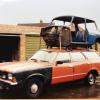
Lunar lift-off
Half a century on from the Apollo missions, plans are indeed advanced to send men (and probably women as well, this time) to the Moon, with several organisations now trying to design missions.
While Apollo was the watchword for the first lunar missions launched by NASA, the second iteration of government-backed crewed Moon journeys will carry a different name: Artemis.
It’s a fitting name; in Greek mythology, Artemis was the twin sister of Apollo. While Apollo was a solar deity, Artemis was always associated with the Moon.
The Apollo LM is so far the only vehicle to have ever taken humans onto the moon and was developed and built by Grumman Aerospace, now part of Northrop Grumman. The company won the contract after 11 companies were invited to bid, with the process beginning in 1962. Once again, the builder of the Artemis LM will be decided by a competitive bidding process. This began in May of this year, making the deadline somewhat quicker than in Apollo’s case. Again, 11 companies have been invited to conduct studies and select prototypes for a prospective lander.
Artemis-1 is scheduled for July 2020: it will be the first flight of Orion atop the new space launch system (SLS) rocket, based on systems originally developed for the Space Shuttle. It will be a 10-day mission that will catapult an empty Orion capsule around the moon, returning directly to earth. Artemis-2, scheduled for 2022, will be another SLS launch, this time sending a crew on a lunar orbital trip (this would be the equivalent of 1968’s Apollo 8 mission, which was the third flight of the Saturn V launcher).
Scheduled to launch in 2024, Artemis-3 will send a crew in an Orion module to rendezvous with the Deep Space Gateway (DSG) space station where its crew will transfer into the lunar modules. These will be launched to lunar orbit, from where the descent and return modules will detach to take the crew to the Moon’s surface. The landing site is currently planned to be near the lunar south pole, a location of intense interest because it is believed to harbour water ice deposits in sections of craters that are in permanent shade, where temperatures drop are continuously below -100°C.
As with Apollo, the descent module will remain on the moon, while the return module will detach to dock with the transfer module in orbit. The return and transfer modules will fly back to the DSG. The crew will then disembark from their lunar shuttle back into Orion, which will return them to Earth. This differs somewhat from the Apollo approach, which used the conical command module and its attached cylindrical service module as the vehicle to go all the way from Earth into lunar orbit. For Artemis, the command and service modules for crewed missions will not go to the Moon, and there will be no need for the Artemis-3 SLS to also carry a LM (lunar module), as was the case with Apollo. This will save on its launch weight.
The Full Article in 'The Engineer' magazine here:-
https://www.theengin...nar-lift-off-2/
Edited by mab01uk, 22 July 2019 - 07:20 PM.



















